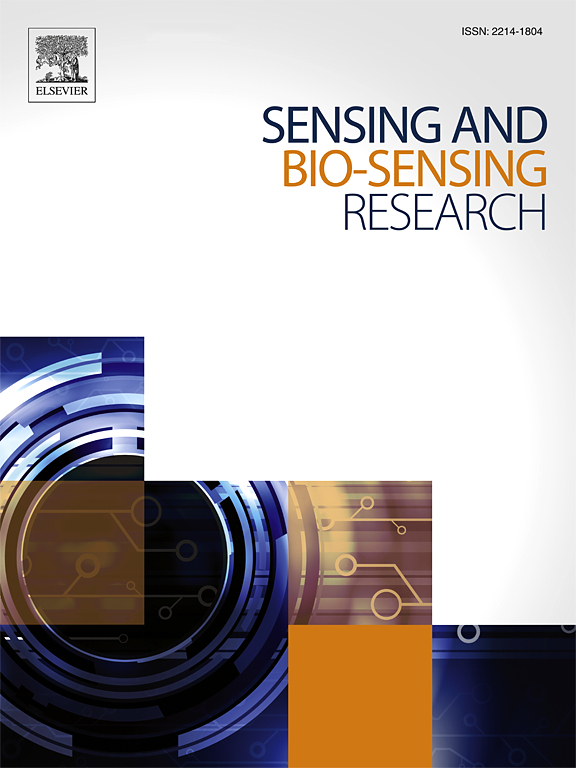基于光子晶体的HIV病毒载量定量生物传感平台的评价
IF 4.9
Q1 CHEMISTRY, ANALYTICAL
引用次数: 0
摘要
准确定量HIV病毒载量(VL)对监测抗逆转录病毒治疗(ART)疗效至关重要。传统的VL检测方法通常很昂贵,并且需要集中的实验室基础设施,这限制了它们在资源受限环境中的可及性。在目前的研究中,我们提出了一种基于光子晶体(PhC)的光学生物传感器,该传感器具有抗hiv -gp120抗体的功能,用于灵敏检测HIV-1假病毒。表征技术,包括动态光散射,zeta电位分析,紫外可见光谱和扫描电子显微镜,证实了有效的抗体-分析物相互作用。透射光谱显示显著的共振波长位移对应于不同的病毒滴度。所提出的生物传感器具有可靠的检测和定量,低至0.99 × 10−3 TCID50/ml (D3)的浓度,具有可测量的共振波长位移,与背景信号明显区分。检出限低至0.99 × 10−3 TCID50/ml。实时定量PCR (rt-qPCR)验证了该生物传感器的灵敏度。这些发现强调了基于phc的生物传感器作为一种快速、准确和可获取的HIV VL监测平台的潜力,特别是在低资源环境中。本文章由计算机程序翻译,如有差异,请以英文原文为准。
Evaluation of a photonic crystal-based biosensing platform for HIV viral load quantification
Accurate quantification of HIV viral load (VL) is critical for monitoring antiretroviral therapy (ART) efficacy. Traditional VL testing methods are often expensive and require centralized laboratory infrastructure, limiting their accessibility in resource-constrained settings. In the current study, we present a photonic crystal (PhC)-based optical biosensor functionalized with anti-HIV-gp120 antibodies for the sensitive detection of HIV-1 pseudovirus. Characterization techniques, including dynamic light scattering, zeta potential analysis, UV–visible spectroscopy, and scanning electron microscopy, confirmed effective antibody-analyte interactions. Transmission spectroscopy revealed significant resonance wavelength shifts corresponding to varying viral titers. The proposed biosensor demonstrated reliable detection and quantification down to a concentration of 0.99 × 10−3 TCID50/ml (D3), with measurable resonance wavelength shifts clearly distinguishable from background signals. The detection limit was as low as 0.99 × 10−3 TCID50/ml. Validation with real-time quantitative PCR (rt-qPCR) demonstrated the biosensor's sensitivity. These findings underscore the potential of the PhC-based biosensor as a rapid, accurate, and accessible platform for HIV VL monitoring, particularly in low-resource environments.
求助全文
通过发布文献求助,成功后即可免费获取论文全文。
去求助
来源期刊

Sensing and Bio-Sensing Research
Engineering-Electrical and Electronic Engineering
CiteScore
10.70
自引率
3.80%
发文量
68
审稿时长
87 days
期刊介绍:
Sensing and Bio-Sensing Research is an open access journal dedicated to the research, design, development, and application of bio-sensing and sensing technologies. The editors will accept research papers, reviews, field trials, and validation studies that are of significant relevance. These submissions should describe new concepts, enhance understanding of the field, or offer insights into the practical application, manufacturing, and commercialization of bio-sensing and sensing technologies.
The journal covers a wide range of topics, including sensing principles and mechanisms, new materials development for transducers and recognition components, fabrication technology, and various types of sensors such as optical, electrochemical, mass-sensitive, gas, biosensors, and more. It also includes environmental, process control, and biomedical applications, signal processing, chemometrics, optoelectronic, mechanical, thermal, and magnetic sensors, as well as interface electronics. Additionally, it covers sensor systems and applications, µTAS (Micro Total Analysis Systems), development of solid-state devices for transducing physical signals, and analytical devices incorporating biological materials.
 求助内容:
求助内容: 应助结果提醒方式:
应助结果提醒方式:


